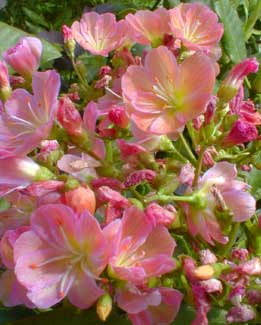
Cupped "Number 17 Pink"
Cliff Maids, or
Thick-leafed Bitterroot
"She dwelt among the untrodden ways
Beside the springs of Dove, --
A maid whom there were none to praise
And very few to love."
-William Wordsworth
(1770-1850)
(1770-1850)
This lewisia was obtained at Whitney Gardens, in the shadow of the Olympic Mountains.
It was labeled with the grower's tag "Lewisia number 17 Pink." But we call it "Cupped Pink" because the flowers on this individual plant are always cup-shaped & never the fully flattened starflowers usually expected of Lewisia cotyledon.
But another specimen that was also labeled Number 17 Pink had its flowers reflexed, so as with nearly all lewisia strains, there is considerable variation plant to plant.
It has an unusual multi-colored flower, a soft lemony yellow in the yeart, & bright shades of matte-pink & peach over the bulk of each petal.
All species of Lewisias (of which there are possibly nineteen) are native to the western United States. Most species are slightly to terribly difficult to grow, but L. cotyledon & especially its garden-originated varieties are pretty darned easy, so long as they get the sharpest possible drainage & never sit long in wetness.
The foliage, reminiscent of saxifraga, hen-&-chicks, or sedums, is evergreen, though during dormant periods it can become very beaten down. If too often wet the lower leaves will rot, with the highest risk in winter. The cold doesn't bother them, but winter rainfall can be an enemy. In summer, lewisias easily survive droughty conditions but will do so by shrivelling up until a bit of moisture returns. The right balance of enough water to not go into a withering state, but dry enough to not risk root-rot, is easily managed so long as they are planted where drainage is ultra-sharp, such as along stone ledges.
I almost never fertilize the lewisias. In their natural settings they are frequently seen sticking out between rocks on cliff faces where there is hardly any soil, or on gravelly slopes where little or nothing else can get a foothold. Ours flower so very intensely & serially for such a long time, they are obviously removing nutrients from their soil at a steady clip. Yet after years without being fertilized, they have never seemed to decline in flower-strength.
I have never found adequate expert recommendations on how often they would like to be fertilized were I to begin doing so. But if an error is made, it should be on the side of far too little rather than a little too much.
When I remove spent flower stems to help induce rebloom, I twist to break up each handful of the easily crunched-up succulent stems & sprinkle them back into the general area so that nutrients will be recycled back into the soil rather than carted off to compost. Sometimes there are so many crunched-up stems of spent blooms that the soil is competely hidden, so I can't sprinkle them too close around the lewisias which do not want to be mulched (unless with gravel or pumice) because they want the top of the soil to dry out swiftly.
Certainly their nutrient needs are slight because they thrive in poor light soil, & it's my belief that fertilizing them often would do more harm than good, though it also seems unlikely that my my reluctance to fertilize them at all will be a good thing indefinitely. I know of no field trials that establish what the correct balance would really be.
Likely generalizations would be to feed very lightly with slow-release acid evergreen fertilizer or fine compost or bulb fertilizer, once a year at most, with the probable ideal timing immediately after its first flush of flower late in spring.
Lewisia cotyledon Siskiyou Pink